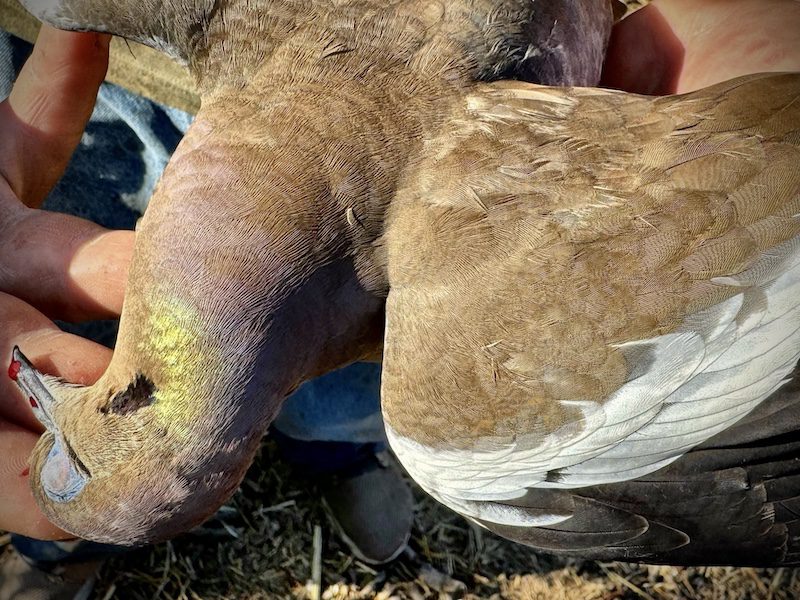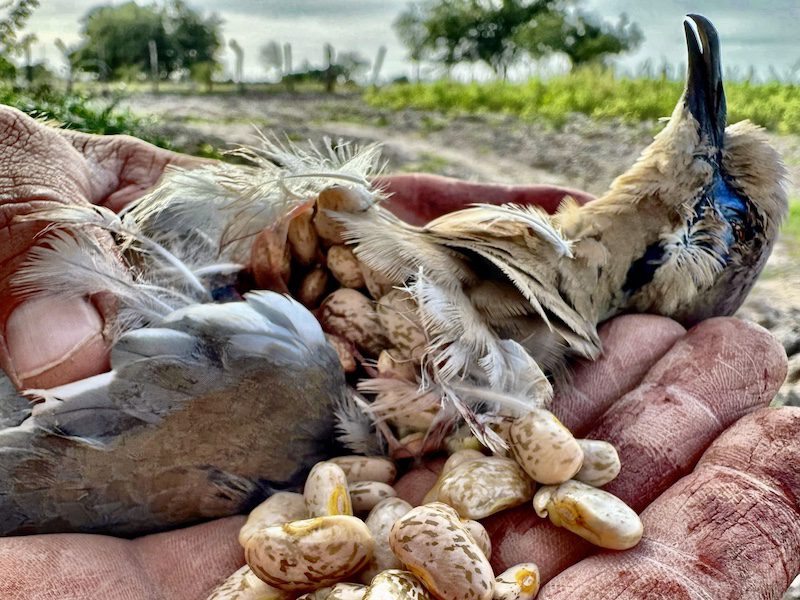White-winged Dove
White-winged dove (Zenaida asiatica) is a medium-sized bird belonging to the dove family, Columbidae. This species is primarily found in the southwestern United States, Mexico, and Central America, with some populations extending into parts of the Caribbean. The white-winged dove is characterized by its striking appearance, with distinct white patches on its wings that contrast sharply against its pale grayish-brown body. Adults typically measure between 28 to 31 centimeters (11 to 12 inches) in length and weigh around 150 to 170 grams.

In terms of habitat, white-winged doves inhabit a variety of environments, including desert scrub, open woodlands, agricultural areas, and suburban landscapes. They are highly adaptable birds and can thrive in both natural and human-altered habitats. These doves are often associated with areas containing mesquite trees, which provide them with important food and nesting resources.
White-winged doves are primarily seed-eaters, with a diet that includes a variety of seeds, grains, fruits, and occasionally insects. They are known to forage on the ground or in low vegetation, using their strong bill to crack open seeds and fruits. During the breeding season, they may also consume more protein-rich foods to support reproduction.

Available Hunts
-
Mexico Duck Hunting Nayarit
I invite you to experience authentic Mexico duck and dove hunting at its very best. INCLUSIVE Mexico Duck Hunting Nayarit Combo is genuine yesteryear Mexico duck hunting
...read moreAvailable only through GetDucks.com, the Nayarit Mexico duck hunt combo package represents superior bang-for-the-buck value and is truly inclusive, including everything but flying into to Mazatlan and the ammo you shoot.
- Includes everything but flying into Mazatlan and your ammo. That’s it!
- Morning ducks, afternoon doves, 6 hunts, generous limits
- Prized species include blue-winged teal, cinnamon teal, green-winged teal, northern shovelers, black-bellied whistlers, fulvous whistlers, more.
- Minimum 4 hunters, maximum 6, exclusive groups only.
- Best, most authentic meals in Mexico.
- Minimum 4 hunters
Rate: $4,240 INCLUSIVE -
Mexico Duck Hunting Obregon
Mexico duck hunt combo for real duck hunters. All-day hunts for broad variety of Central Flyway and Pacific Flyway duck species.
...read moreMexico duck hunting combo in Obregon is an action-packed “real duck hunters duck hunt” for ducks, doves, options for trophy bass fishing and quail.
- Trophy duck species for nearly all Central and Pacific flyway species to include cinnamon teal, Mexican mallard, more!
- Generous bag limits
- Elegant and Gambel’s quail, trophy largemouth bass fishing options
- Premium, 9-bedroom estancia and unequalled guest services
- Featured – Wildfowl, World of Beretta, MOJO TV, Outdoor Life, NRA Hunter, more
Rate: $4,880 (4-day hunt) -
Mexico Duck Hunting Sonora
Mexico Duck Hunt package is intended for private groups of 4-7 hunters.
...read moreMexico Duck Hunting Sonora Combo was developed at the request of many repeat clients who wanted to enjoy morning Mexican duck hunting, afternoon dove hunts, with their own exclusive groups.
- 4-night, 3-day packages, January-February
- For private groups of 4-6 hunters
- Morning duck hunts, afternoon dove hunts
- Premium, 4-bedroom estancia, all bedrooms with ensuite facilities
- Excellent waterfowl species selection
Rate: $4,080 (3-day hunts) -
Mexico White-winged Dove Hunting
Old school Mexico White Wing Dove Hunting is much closer to home, offers amazing shooting opportunity.
...read more- Expect to shoot 15-20 boxes per hunt
- Only 1/2 day travel from most US cities
- Spacious, well-appointed lodge comfortably accommodates up to 18 guests
- First-class guest services, absolutely no detail is spared
- Large-group and corporate packages available
- As featured in Sporting Classics (Mar/Apr 2016)
Rate: $3,250 -
Texas Duck Hunting – Gulf Coast Redheads and More
Run-N-Gun Adventures accesses the greatest percentage of the entire world’s population of overwintering redheads on nearby Laguna Madre and surrounding areas for the Texas duck hunting experience of a lifetime. But LOTS more, too.
...read more- Trophy Redheads on Matagorda Bay
- Pintail, teal, mottled ducks, black-bellied whistlers, white-fronts, snows and more
- 50,000+ acres exclusive, intensively managed properties
- Cast & Blast packages and afternoon hunts available
- NEW 11,000 sqft luxurious lodge, chef-prepared meals
- Located only 1 hour from Houston
Rate: $175-300 day rate/ $1,425 and up packages -
Texas Teal Hunting – Coastal Prairie
Texas blue-winged teal hunting program is BEST - perfect location and management produce a greater concentration of blue-winged teal than many hunters will witness elsewhere in their lives.
...read more- Best blue-winged teal hunt in US, period
- Limits are the rule, not the exception (5.5 teal per hunter average)
- Short 16-day September season
- Convenient to Houston, Texas
- Executive lodging for 21 guests, southern home-cooked meals
- Youth hunter discounts
- As seen on MOJO TV and in Wildfowl Magazine
Rate: $500
Breeding typically occurs from spring to summer, with peak activity often correlating with the availability of food resources. White-winged doves are monogamous and form pair bonds that can last throughout the breeding season. Nests are often constructed in trees or shrubs, with both members of the pair contributing to nest-building activities. The female typically lays two white eggs, which are incubated by both parents for about 14 to 16 days. After hatching, the chicks are fed crop milk, a specialized secretion produced by the parents, before transitioning to a diet of regurgitated seeds and fruits.
White-winged doves are known for their distinctive cooing calls, which are often heard throughout their range. These vocalizations play an important role in communication, particularly during courtship and territorial defense. They are also known to engage in visual displays, such as puffing out their chests and fanning their tails, to assert dominance or attract mates.
Overall, the white-winged dove is a widespread and adaptable species with a distinctive appearance and vocalizations. While populations are generally stable, they may face threats from habitat loss, urbanization, and pesticides in agricultural areas. Conservation efforts focused on habitat preservation and management are important for ensuring the continued survival of this iconic bird species.








